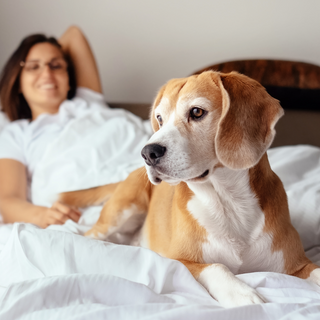Checking the Health of Your Dog’s Fur
Your dog’s fur is a direct reflection of their overall health. A glossy, full coat often signals wellbeing, while changes in texture, thickness, or appearance can be early signs of underlying issues. Regular checks help you catch problems early and keep your dog feeling comfortable and looking their best. Here's a quick and simple guide to help you assess your dog’s coat health at home.
Look for Shine and Softness
Healthy fur typically has a natural sheen and feels soft or smooth to the touch (even in rough-coated breeds). Dull, dry, or brittle hair may indicate poor nutrition, dehydration, or skin issues. If your dog’s coat has lost its lustre, consider reviewing their diet, checking their hydration, and consulting your vet if the problem persists.
Run Your Fingers Through the Coat
Gently comb your fingers through your dog’s fur, from head to tail and down the sides. You should be able to move through the coat easily, without encountering knots, tangles, or greasy buildup. Mats or clumps can trap moisture and bacteria, especially in long-haired breeds, and may require professional grooming.
Check for Bald Patches or Uneven Shedding
Some shedding is normal, especially seasonally, but look out for bald spots, excessive hair loss, or fur that comes out in clumps. These can be signs of allergies, hormonal imbalances, parasites, or infections. If you notice new or worsening bald patches, it’s time for a vet visit.
Examine the Skin Beneath
Part the fur and look at the skin underneath. It should be pale pink (or pigmented, depending on breed), smooth, and free of flakes, redness, sores, or bumps. Red, inflamed, or flaky skin could point to dermatitis, allergies, or parasites such as fleas and mites.
Smell the Coat
A dog’s natural scent is normal, but a strong, unpleasant odour can signal yeast infections, bacterial overgrowth, or poor grooming. If your dog still smells bad even after a bath, or if the smell returns quickly, this could mean there's a deeper issue at play.
Feel for Even Thickness
The coat should feel consistent all over—thicker in some areas depending on breed, but not patchy. Pay attention to areas that seem especially thin or uneven. Rapid changes in thickness might be due to stress, seasonal shifts, or health concerns such as hypothyroidism.
Observe Behaviour
Is your dog scratching, licking, or biting at their coat more than usual? This could mean discomfort, allergies, parasites, or dry skin. Constant grooming or irritation shouldn’t be ignored, even if the coat looks fine at first glance.
Watch for Changes After Diet or Environmental Shifts
If you’ve recently changed your dog’s food, moved to a different climate, or introduced new household products (like cleaners or air fresheners), be alert to any changes in coat condition. Fur is sensitive to internal and external changes, and even subtle irritants can affect its health.
When in Doubt, Ask a Vet
Routine brushing and coat checks are a great first defence, but if something doesn’t seem right—excessive shedding, odour, texture changes, or persistent skin problems, your veterinarian can help determine the root cause and offer treatment.
By keeping a regular eye (and hand) on your dog’s coat, you’re not just maintaining appearance, you’re tuning into their health, comfort, and quality of life. A healthy coat doesn’t just look good; it feels good, too.

- Choosing a selection results in a full page refresh.


